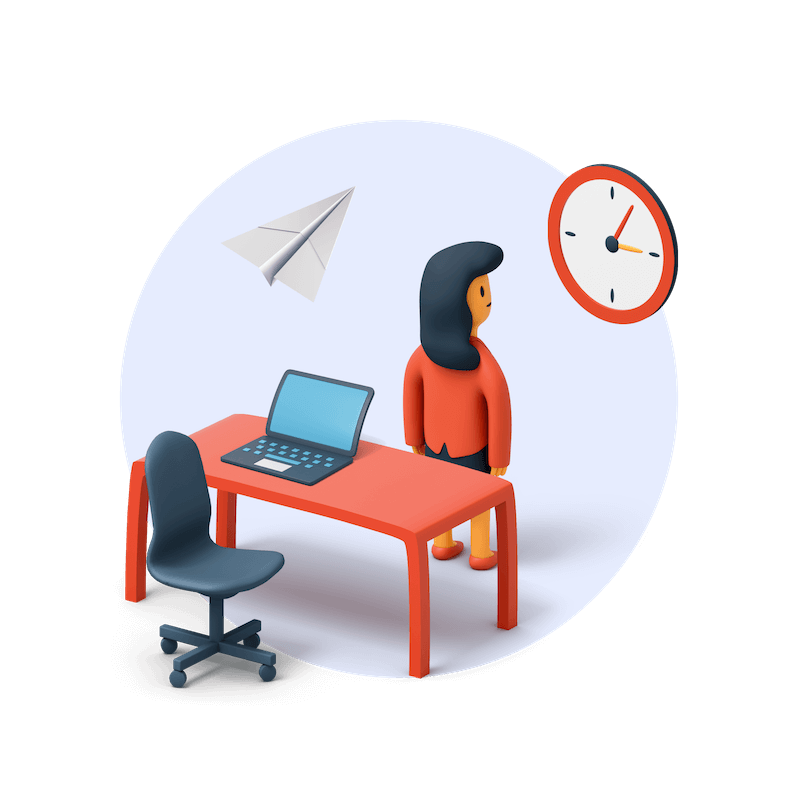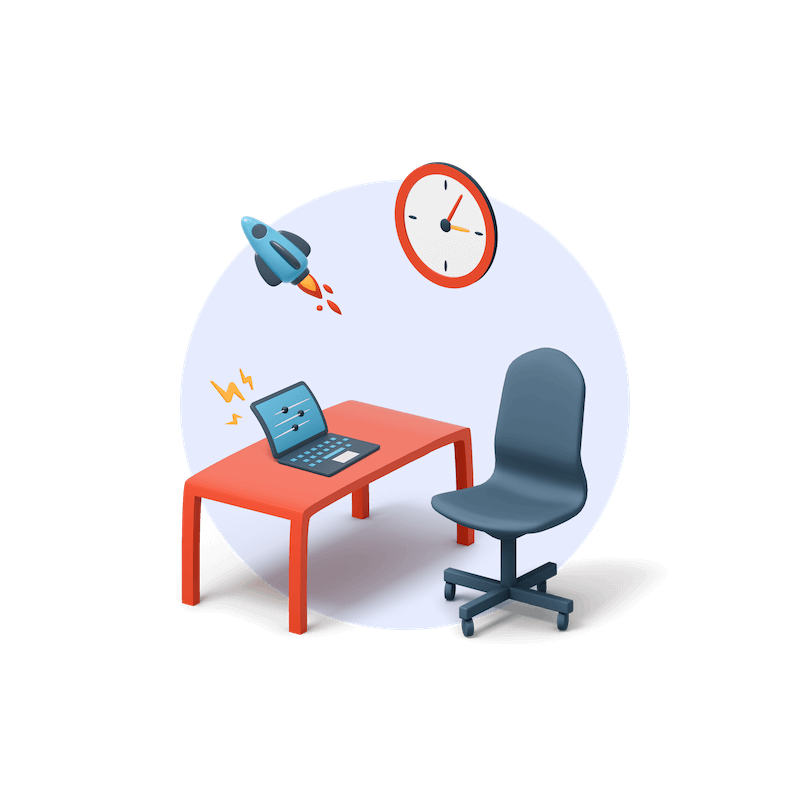The term “workaholic” has become a popular buzzword in recent years, but what does it really mean?
Workaholism is defined as an addiction to work or an obsessive-compulsive behavior that involves excessive and compulsive involvement in activities related to one’s job. It can lead to burnout, physical and mental health conditions, and even relationship problems if not managed properly.
If you’re a workaholic, you probably feel the need to push yourself beyond your limits in order to succeed at work. You may find it difficult to take breaks or rest days, believing that taking time off means losing ground on your goals. This type of behavior can be damaging both personally and professionally if left unchecked.
At Quidlo, we’ll explore some facts and statistics about workaholism so you can gain a better understanding of this phenomenon. We’ll look at the prevalence of workaholism around the world, its effects on people’s lives, how it relates to other psychological disorders, and potential solutions for managing these behaviors more effectively.
Ready? Let’s go.
Table of Contents
Workaholism Around The World
Workaholism is a growing problem around the world, with an estimated one in five people suffering from work addiction or obsessive-compulsive behavior related to their job.
Business Insider ranked the 14 most workaholic countries in the world from least to greatest. They took into account the number of federal holidays, the percentage of people who take all their allotted vacation days, and the average hours worked per year.
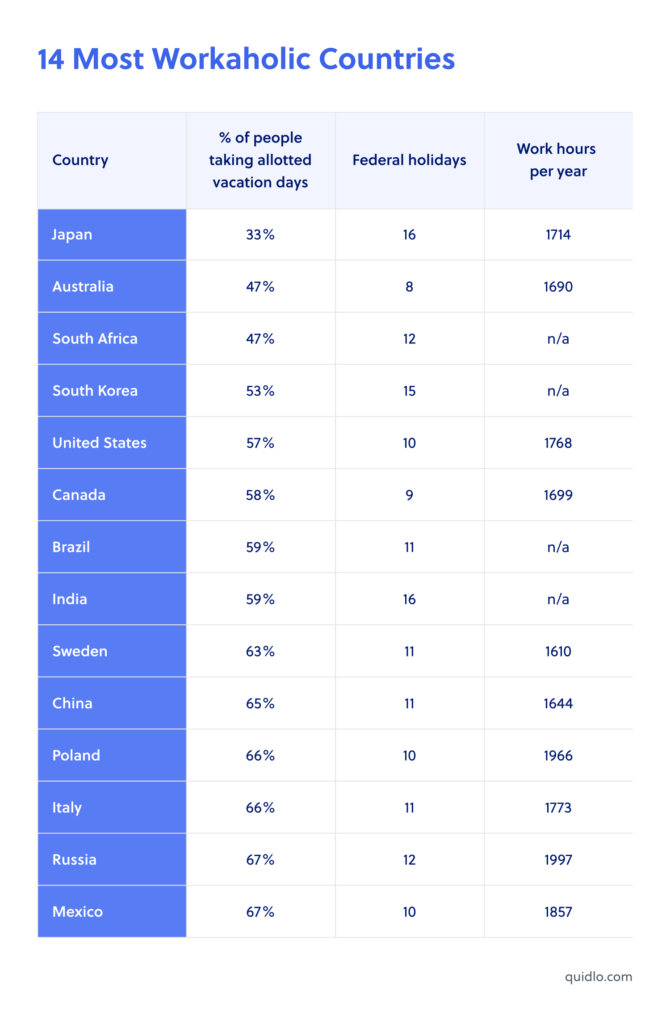
As you can see, workaholism is a global problem. While many countries offer generous holiday and vacation policies, it’s clear that people often don’t take advantage of them, leading to an increase in work addiction. Time off is important for the average worker to actually use and enjoy. So, if you’re feeling burnt out and in need of a break, don’t be afraid to use those vacation days! Your work (and sanity) will probably thank you for it.
Workaholism in Japan
Looking at the list, Japan’s workaholism is especially concerning, given the extremely low rate of people who take all their allotted vacation days. Did you know that 1 in 4 firms in Japan say workers used to log over 80 overtime hours a month?
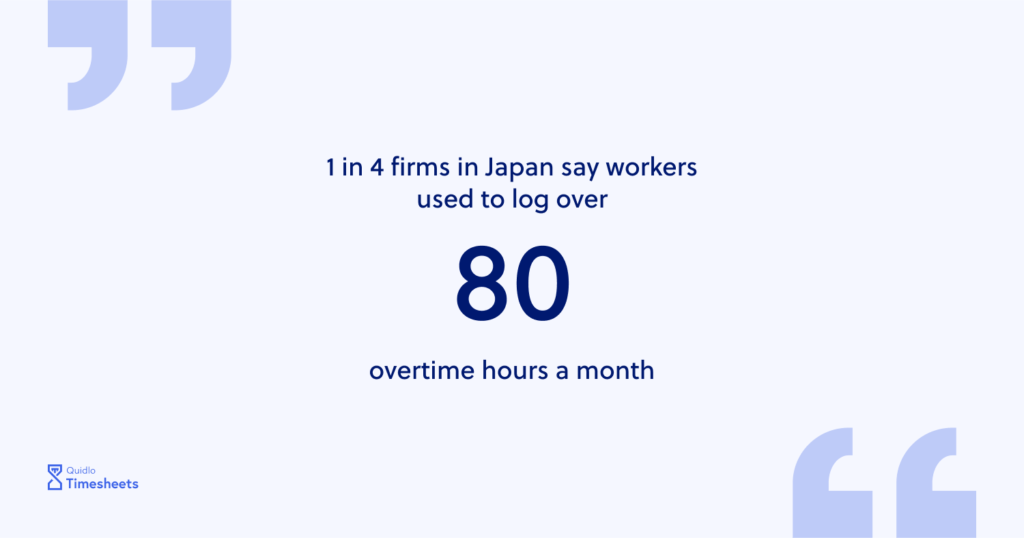
Let’s take a deeper look at what’s going on.
Japanese Work Culture
Japan is known for having a tough work culture with a strong emphasis on dedication to one’s job. It’s rather common for Japanese workers to feel guilty about taking vacation time, with only 52% of the participants agreeing that a work-life balance is essential. To make matters worse, a whopping 53% of Japanese people don’t even know about how much annual leave they have.
This level of dedication to work has made many Japanese employees unhappy – in fact, the country ranked last out of 35 countries on a job happiness index by Indeed. However, things have been improving in recent years, with a decrease in the average number of working hours and more companies taking steps to reduce overwork. While the work culture in Japan is still evolving, it’s slowly moving towards a healthier balance between work and personal life.
Why do the Japanese overwork?
So why do people in Japan work longer hours than most countries? Well, there are a few different factors at play here.
For one, the country has a long history of valuing diligence and perseverance. Hard work is seen as an essential part of being successful, leading to a culture where overwork is often seen as something to be proud of.
According to Nippion, there are three main social factors behind this tragic phenomenon:
- The desire to compete with the West: The Meiji restoration in 1868 led to a desire for Japan to become an industrialized country and compete with Western nations, which required a lot of hard work and dedication from the workforce.
- Collectivist mindset: The collectivist culture in Japan expected workers to prioritize the company over themselves, which gave corporations the power to ignore their employees’ rights, and labor unions were not powerful enough to push for changes to benefit the workers.
- Availability of convenient services: The Japanese value convenience, services such as 24/7 retail and delivery are good for customers but they require employees to work graveyard shift to facilitate this convenience, which can lead to overwork and job stress.
It’s important to note that Karoshi is a serious issue in Japan, the next section will detail how it impacts the Japanese work culture. Overall, while the Japanese work ethic is admirable, it’s essential for the well-being and safety of the employees that the overworking should be addressed and prevented.
Japan Work Culture Karoshi – Death Numbers
Have you ever heard of the term ‘karoshi’? It’s a Japanese word that means ‘death by overwork’. It’s a real thing and it’s been around for decades.
The term gained more attention in recent years when a young woman named Matsuri Takahashi died from overworking in 2015. But the history of karoshi actually goes back to the early 20th century when workers in Nagano prefecture were forced to work 14 hours a day in inhumane conditions.
It wasn’t until the 1970s that doctors in Japan began to notice an increase in deaths related to work stress and coined the term ‘karoshi’. And the issue really came to the forefront in the late 1980s, just as Japan was entering an economic recession.
The leading causes of karoshi are heart disease, stroke, and suicide. According to the Japan Times, there were 96 deaths due to heart attacks and strokes from overworking just in 2015. And the National Police Agency reported 2,159 suicide cases that year that were related to work.
Workaholism In The United States
A new study of 2,000 employed Americans found that nearly half of them (48%) consider themselves to be modern-day “workaholics”. But interestingly, they also found that only 28% of them worked hard out of financial necessity.
Additionally, Deloitte’s external marketplace survey of 1,000 full-time US professionals provides some more interesting stats to consider:
77% of Americans who work full-time have experienced burnout at their jobs – this might have something to do with the fact that 94% of service professionals put in 50+ hours a week, according to a Harvard Business School survey.
Nearly 70 percent of professionals feel their employers are not doing enough to prevent or alleviate burnout within their organization.
Nearly half of millennials say they have left a job specifically because they felt burned out
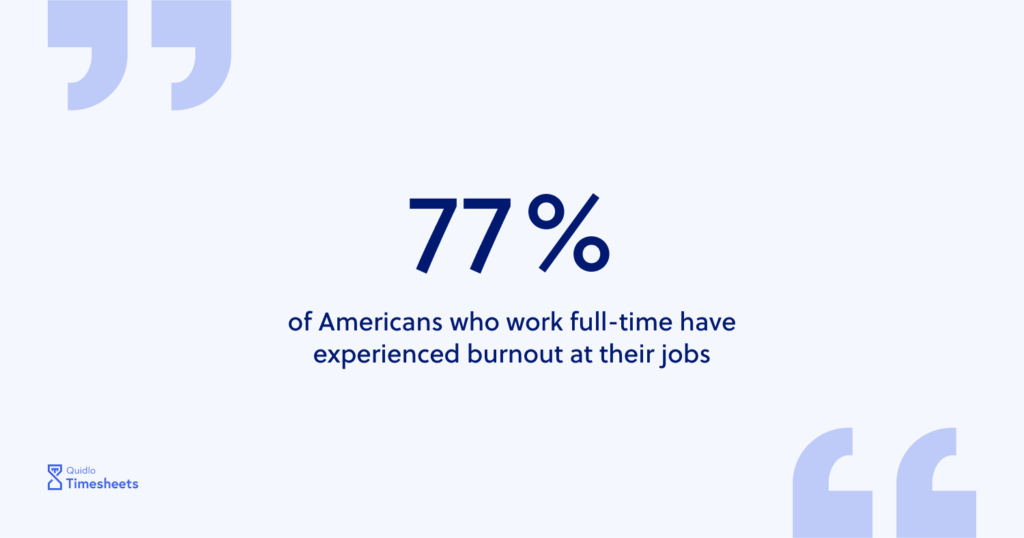
And if you’re wondering if you might be one yourself, here are some signs to look out for:
Worrying about work on your days off
Feeling too busy to take a vacation
Checking your emails in bed after you wake up. In fact, 58% of American office workers admitted to checking their work email while still in bed!
A cluster analysis investigation of workaholism as a syndrome published in the Journal of Occupational Health Psychology also reinforced a three-dimensional scale of workaholism that involved:
High work involvement,
High drive to work
Low work enjoyment
A more scientific way of determining whether you’re a workaholic is by using the Bergen Work Addiction Scale (you can check out this work addiction risk test here).
It’s not just about the long hours, it’s also the fact that Americans are constantly thinking about work and career development. The study mentioned earlier in the NY post also found that the average employed American works four hours a week for free, and spends an additional four hours a week just thinking about work!
Workaholism In China
Did you know that people call the work culture in China the “996”? Guess what that means.
It’s their version of a 9-5. Except, instead of an eight-hour day, it’s a 12-hour one. That’s right, Chinese workers are expected to work from 9 am to 9 pm, six days a week. Employees in China also tend to score higher for Workaholism than employees in Western European countries and the United States.
It’s a big problem, especially for young urban millennials and members of Generation Z. They’re feeling the intense stress and extreme competition of daily life, and they’re calling it “involution” (neijuan in Chinese), which means feeling like you’re on a treadmill going nowhere.
And it’s not just the long hours that are the problem, it’s also the pressure that starts as early as kindergarten. Children are groomed by their parents to compete for high scores in university entrance exams. The stress and burnout are taking a toll on mental and physical health, and younger Chinese workers feel like the long hours aren’t paying off in terms of higher living standards, especially amid slowing economic growth.
That’s why there’s a growing resistance to China’s ultra-competitive culture among young people across social media, centered around online calls for people to “lie flat” or do the minimum and push boundaries of what’s socially acceptable in this industrious nation. People are finding solace in alternative lifestyle options like co-living communities springing up around the country, which offer a more laid-back existence.
Workaholism In Europe
The Europeans have a more relaxed attitude towards their working hours and prioritize spending time with family, friends, and leisure activities over the job itself. In fact, studies have found that employees in countries like Germany, Austria, and Finland are some of the least stressed-out workers in Europe. This is likely due to the fact that these countries are known for their strong labor laws, which protect employee rights and set reasonable boundaries for working hours.
But that doesn’t mean Europe is immune to workaholism. A new EU-OSHA’s workers’ survey shows that 44% say workplace stress has increased from the pandemic, with 46% dealing with severe time pressure or work overload.
On average, full-time employees in the European Union put in 36.4 hours a week at their main job. But, if you’re living in Romania or Bulgaria, you’re probably clocking in a bit more, with an average of 40.5 and 40.4 hours a week, respectively. And get this, in Belgium, employees were working 39.1 hours a week, but for the self-employed, it jumps up to 52.8 hours a week. So, if you’re self-employed in Belgium, you might want to take a vacation soon.
Workaholism in the UK
A recent UK-based survey of 2,000 employees found that four in ten adults admit they can’t shut off after work, with one out of every six individuals regularly working more than 11 hours a week remotely, catching up on emails and phone calls.
Emails are especially a huge problem for UK workers with workaholic tendencies.
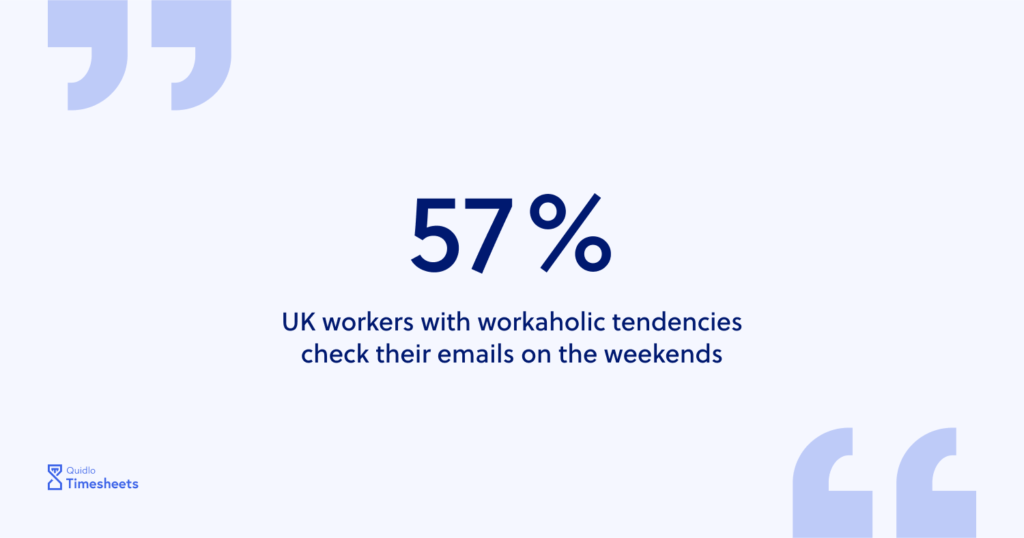
57% check their emails on the weekends
30% check them throughout the night
20% check them while they’re still in bed.
It gets worse: 16% can’t even eat without checking their emails, which is why 1 in 5 of them have health problems. To top it off, 97% of the people surveyed take work home with them and can’t seem to leave on time.
Workaholism in Norway
Now, let’s talk about Norway.
A nationwide survey found that 8.3% of employees are workaholics. That’s about one in twelve Norwegians. This is higher than the European average of 7%. Some other important findings were:
The age group where workaholism is most prevalent is 46-58 years old (36.5%)
Women are slightly more susceptible to workaholism than men (51% vs 49%)
Workers living with a partner are much more susceptible than those who aren’t (82.5% vs 17.5%)
Workers without childcare responsibility are more susceptible than those with it (57% vs 43%)
Full-time workers are more susceptible than those with a lower full-time equivalent (78.3% vs 21.7%)
Those with vocational school education are most likely to be workaholics (33.7%)
So it seems that those with a family, a partner, and higher levels of education are more prone to workaholism in Norway.
These statistics show us that workaholism is an issue not just limited to one country or region, but is present all around the world. No matter where you live, it’s important to be mindful of your own work-life balance and make sure you’re taking care of yourself. So take a break, go for a walk or call up a friend, just don’t forget to enjoy your personal life!
Workaholism by Industry
It’s no secret that certain industries are more prone to workaholism than others. While some jobs require long hours and extra effort, there are other occupations where overtime is not necessary but still expected by employers. To get a better understanding of this phenomenon, let’s take a look at the statistics on workaholism by industry, according to Yahoo Finance.
- Mining – 48 hours
- Agriculture, Forestry, and Fishing – 40 hours
- Construction – 40 hours
- Electricity, Gas, Water, and Waste Services – 40 hours
- Financial and Insurance Services – 40 hours
- Professional, Scientific, and Technical Services – 40 hours
- Wholesale Trade – 39 hours
- Information Media and Telecommunications – 38 hours
- Manufacturing – 38 hours
- Public Administration and Safety – 38 hours
Workaholism in IT
The IT industry, in particular, has a reputation for encouraging long hours and stressful work environments. There’s this thing called technostress, which is a type of workaholic stress from working with computer technology on a daily basis. The symptoms include:
Anxiety
Behavioral strain
Exhaustion
Mental fatigue
Poor concentration
Physical diseases
Insomnia
And all that can lead to reduced productivity, decreased job satisfaction, decreased organizational commitment, and increased absenteeism and turnover.
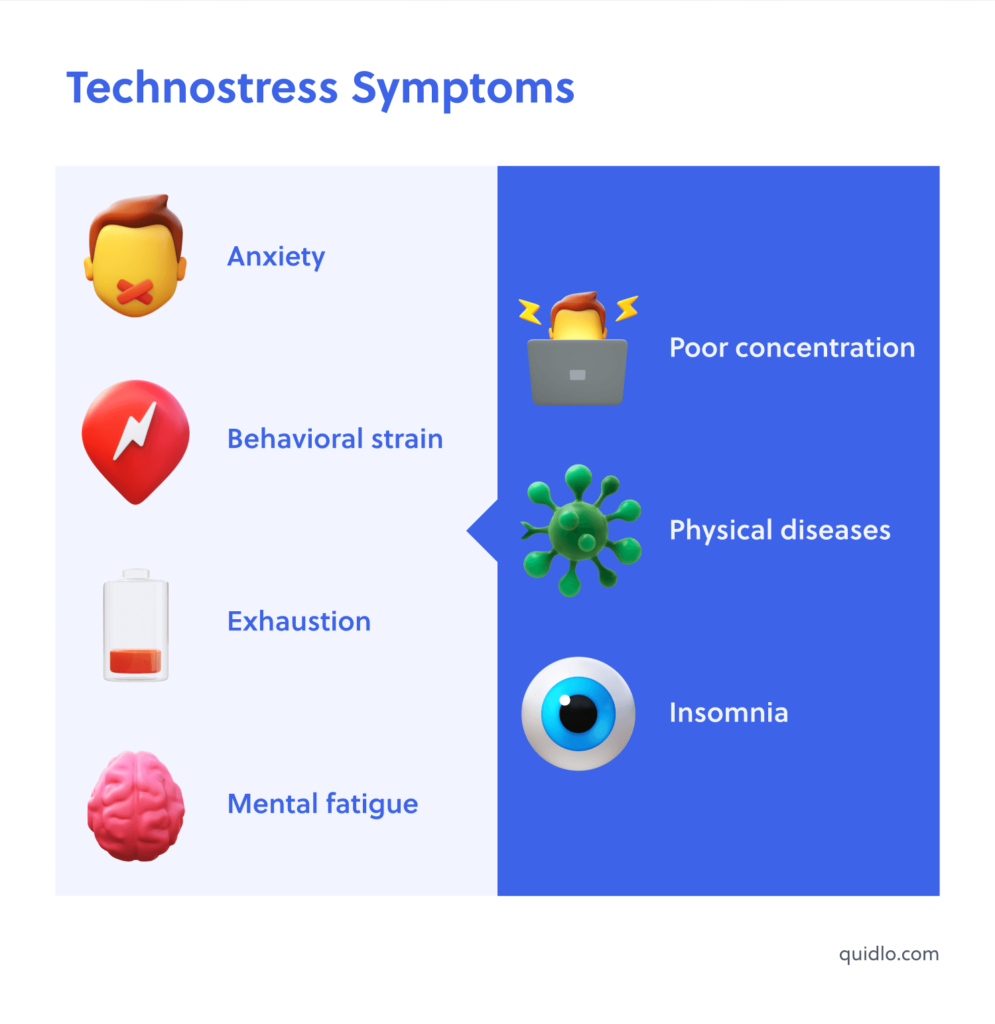
One study tested the relationship between workaholism, technostress, and authoritarian leadership style among university administrative staff who worked remotely during the COVID-19 pandemic. The results showed that the authoritarian leadership style increased workaholism and technostress among remote workers, and that technostress was higher for women.
Another study revealed the strongest influencing factors for workaholism in IT.
Employee remuneration: those with a higher salary tended to put in more hours
The intrinsic pleasure of working
Support from one’s life partner
Sense of responsibility towards one’s family
The need to demonstrate competence
The desire for hierarchical advancement
Fear of losing the job
So, if you’re working in the IT industry, it’s important to be mindful of these factors and take steps to manage your stress levels. You only have so much energy. This could include talking to a colleague, taking regular breaks, and engaging in healthy activities like exercise or meditation for more life satisfaction.
Dealing with crunch
If there’s one sector of IT that has it particularly bad with work-life conflict, it’s the games industry. Crunch, or making employees work long hours and even weekends in order to meet deadlines, is sadly a common occurrence in the gaming industry.
For instance, CD Projekt Red has ordered their development team of the eagerly awaited Cyberpunk 2077 to work overtime (a mandatory six days a week) in preparation for its November launch date in 2020. Blizzard is facing a similar conundrum with the production of Diablo IV, saying the June release date will lead to more crunch.
Game studios have come under heavy criticism for their overworking employees and in 2020, a report was released by the International Game Developers Association (IGDA) showing that one-third of games industry professionals had experienced a crunch in the past year.
Workaholism in Startups
Startups often fall prey to unhealthy work habits and workaholism, and venture capital investors play a significant role in this. The mythology around startups promotes and even requires burn-out efforts in order to meet the short timelines of venture funds. And investors, who only succeed when a startup becomes successful, push for excessive sacrifices from entrepreneurs and employees.
This pressure trickles down and can lead to a culture of overworking, with employees sacrificing their personal lives and well-being for the sake of the company. This can also lead to a lack of proper compensation for the excessive sacrifices made by employees. But research has shown that requiring staff to work excessive hours in your startup can have negative consequences:
- It poses a significant risk to their health, with a 67% increased chance of developing heart disease for those working 11 hours per day compared to 8.
- It also increases the likelihood of alcohol abuse, with those working 50 or more hours per week being three times more likely to develop a problem.
- It diminishes productivity, as 50% of employees experience decreased productivity as a result of stress.
- Losing sleep can have a similar impact to consuming alcohol, with 20 hours of being awake equating to a blood alcohol level of 0.1, equivalent to five or six drinks for those weighing 160-180 pounds.
While the work situation of entrepreneurs can be challenging, it’s not the decisive factor for well-being, rather it depends on how entrepreneurs deal with it – those who don’t engage in work times and detach when they’re supposed to suffer most.
Additionally, many entrepreneurs use perks and incentives to make it appear as though employees choose to work excessive hours, and appeal to a sense of “greater good” in order to justify the sacrifices. However, studies have shown that sleep, recuperation, and sustainable work habits are crucial for overall performance and success, yet many startup employees neglect these in pursuit of success.
Workaholism in Finance
Did you know that more than a quarter of people working in financial services consider themselves workaholics?
The banking and finance industry is no stranger to workaholism, with investment bankers and hedge fund analysts clocking in an average of 60-100 hours per week. It’s a super competitive industry. If one bank can’t get the job done for a client, another one will. And if one analyst can’t handle a task, there’s always another one ready to step in.
This can make for a pretty unpredictable workflow. Banks are always trying to keep their clients happy, even if it means working on unreasonable requests. And analysts are always trying to impress their bosses.
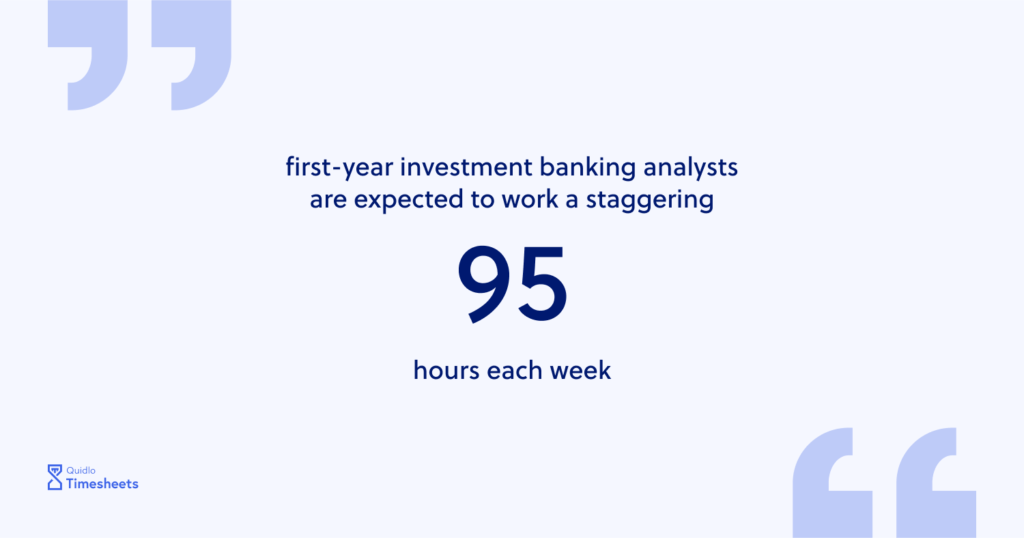
But here’s the thing, sometimes deals happen at the last minute and they just have to be done, no matter the time of day. That’s why you might see some investment bankers pulling all-nighters or working late into the night. It’s just the nature of the industry. In fact, a shocking survey conducted by Goldman Sachs in 2021 revealed that, on average, first-year investment banking analysts are expected to work a staggering 95 hours each week.
Unfortunately, the long hours and lack of work-life balance have become a cultural norm in the industry. Senior bankers might think that because they had to work those hours as analysts, new analysts have to as well. But there’s hope on the horizon. A survey by Goldman Sachs in 2021 suggests that investment banks may be moving towards healthier, more sustainable hours. The survey recommended that Goldman Sachs should cap the workweek at 80 hours, among other steps to improve the well-being of their employees.
Workaholism in Academia
Academia is no exception to workaholism. Long hours of research, writing, and teaching are part of the job for many professors. This can be a great opportunity to make a real impact and progress the field, but it can also mean overworking oneself.
A 2021 State of the U.S. Teacher Survey found that 78% of surveyed faculty members felt job-related stress and burnout, which is significantly more than other employed adults nationally. And one in four teachers reported symptoms of depression. This was largely attributed to long working hours and a lack of autonomy.
Another survey was filled out by over 4,000 Norwegian university staff, including 2186 academics and 2551 technical and administrative staff. They were asked a series of questions to measure excessive and compulsive working.
Whether they felt obligated to work even when it was not enjoyable
Whether they felt guilty taking time off
Whether their job was affecting the way they felt and behaved at home.
They were also asked about the management, support, and resources in place within their university.
The results showed that academics have more traits associated with workaholics compared to non-academic staff. These people reported more conflicts between work and family life, and had higher workloads. Researchers believe that this is because the demands of the job and recent changes in the way universities are governed and managed are making things worse.
Workaholism Affects in Numbers
Workaholism Relationships Facts and Statistics
Workaholism can greatly affect relationships and intimacy. Workaholics may sacrifice their authentic selves to their “doing-and-performing” public persona, and this can lead to the threat of losing control and risking self-annihilation.
Intimacy requires good communication and a reciprocal sharing of power and responsibility, but ‘workaholics may struggle with this as they may be physically present but not emotionally involved’, says Barbara Killinger, Ph.D. in the same article. With a lack of flexible working hours, power struggles can ensue as workaholics assume an autonomous stance in the relationship, and the partner is left in charge of intimacy.
This can lead to blaming accusations and indifference, and can cause the trust, respect, and friendship necessary for real love to be destroyed.
Here are some of the most important stats with workaholism:
Research conducted by the University of North Carolina at Charlotte’s Bryan Robinson has revealed that couples in which one partner is a workaholic divorce two times faster than other marriages, on average.
A Deloitte survey we mentioned earlier says that 83 percent of respondents say burnout from work can negatively impact their personal relationships.
6 out of 10 couples struggle to manage their work and family commitments.
A U.S.A. Today Poll identified a number of things that people sacrifice to stay on top of their work. They found that after sleep (56%):
More than half (52%) gave up recreation and 51% skipped on hobbies
44% admitted they sacrificed time with friends
30% sacrificed family time
Families are also eating together less – back in 1987, 50% of respondents claimed they ate at least one meal with their families on a daily basis. Now, this number has plummeted to 20% of respondents by 2008 — indicating another decline in the chances for socializing with the family.
According to the research by Andreassen et al. (2016), workaholics are two to three times more prone to having Obsessive-compulsive Disorder, Attention Deficit Disorder, depression, or anxiety than individuals who aren’t obsessed with their job. This can have a negative impact on their children due to a lack of bonding, poor communication, and difficulty in maintaining a healthy relationships. Bryan Robinson and his research team at the University of North Carolina found that this, in turn, can cause your children to suffer from higher levels of depression and anxiety, while introducing the likely possibility that they come to mimic your work-related behavior:
Performance-driven perfectionists who judge themselves by their accomplishments, rather than by their inherent worth
Outwardly focused conformists
Approval seekers striving to make up for self-inadequacy
Prone to depression
Self-critical and self-disparaging adults who feel unworthy and incompetent for not being able to meet others’ expectations
Overly serious people who have difficulty having fun
Prone to feelings of disloyalty and guilt for acknowledging a problem in their picture-perfect family, which, on the surface, has provided them with everything
Angry and resentful
Prone to generalized and performance anxiety
Unsuccessful in adult intimate relationships
Chameleons with an undeveloped sense of self
Interestingly, one study did suggest that intimate relationships (with a romantic partner) may act as a ‘stress buffer’ for workaholics. The data showed that workaholics’ personal assessments of their own level of work addiction were in line with the ratings given by their spouse/partner, it played a minimal role in the relationship.
Workaholism Health Facts and Statistics
There’s a ton of negative outcomes for your physical and mental health that come with being a workaholic. Here are some of the health effects you should know.
Workaholism and a Person’s physical health
An EU-OSHA survey (cited earlier) revealed that 30% of respondents experienced health issues (including fatigue, headaches, eyestrain, muscle problems or pain) which they attributed to their work.
A research study conducted in the Netherlands revealed that a shocking 33% of workaholics experience regular migraine headaches due to their strenuous workload.
A meta-analysis on the health effects of long working hours revealed that people with workaholic tendencies have a higher chance of suffering from serious health issues and chronic fatigue. When comparing the impact of working between 35-40 hours per week and 55+ hours, the latter group experienced a 33% increase in their risk of stroke and 13% higher chance of heart disease throughout 7 years.
3% of workaholics feel physically ill when they are not at work, mimicking withdrawal symptoms that are associated with addictive drugs.
People working more than 60 hours a week have a 23% higher chance of getting a job-related injury.
It’s a known fact that workaholics are more stressed than the average employee. They feel constantly overwhelmed and unable to cope with the amount of work they are doing, which can exacerbate health issues like digestive disorders, anxiety, depression, and stress-induced headaches.
When it comes to mental health and workaholism…
16,426 individuals aged 16 to 75 completed surveys to measure their work addiction and self-reported psychiatric disorders such as ADHD, OCD, anxiety, and depression.
The study found that work addiction was associated with a 2-4x higher prevalence of these disorders,
With 34% meeting the criteria for anxiety
33% for ADHD
25% for OCD
and 9% for depression.
The researchers concluded that work addiction is linked to mental health issues and that those with pre-existing psychiatric disorders may be more susceptible to work addiction, which can exacerbate their mental health problems.
Parting words
It’s clear that workaholism can have a serious impact on your physical and mental health, as well as your family relationships. The key is to find balance between work and home life. It’s important to understand how much of your time is being spent on work, take regular breaks from work, socialize with your family and friends, practice relaxation techniques like mindfulness or yoga, and make time for leisure activities.
By taking these measures, you will be able to maintain a better work-life balance and avoid the negative consequences of excessive work.
Read next: Workaholism Treatment: How To Break Work Addiction
Remember, work should be something you enjoy doing, not something you do out of obligation or fear. Good luck!

